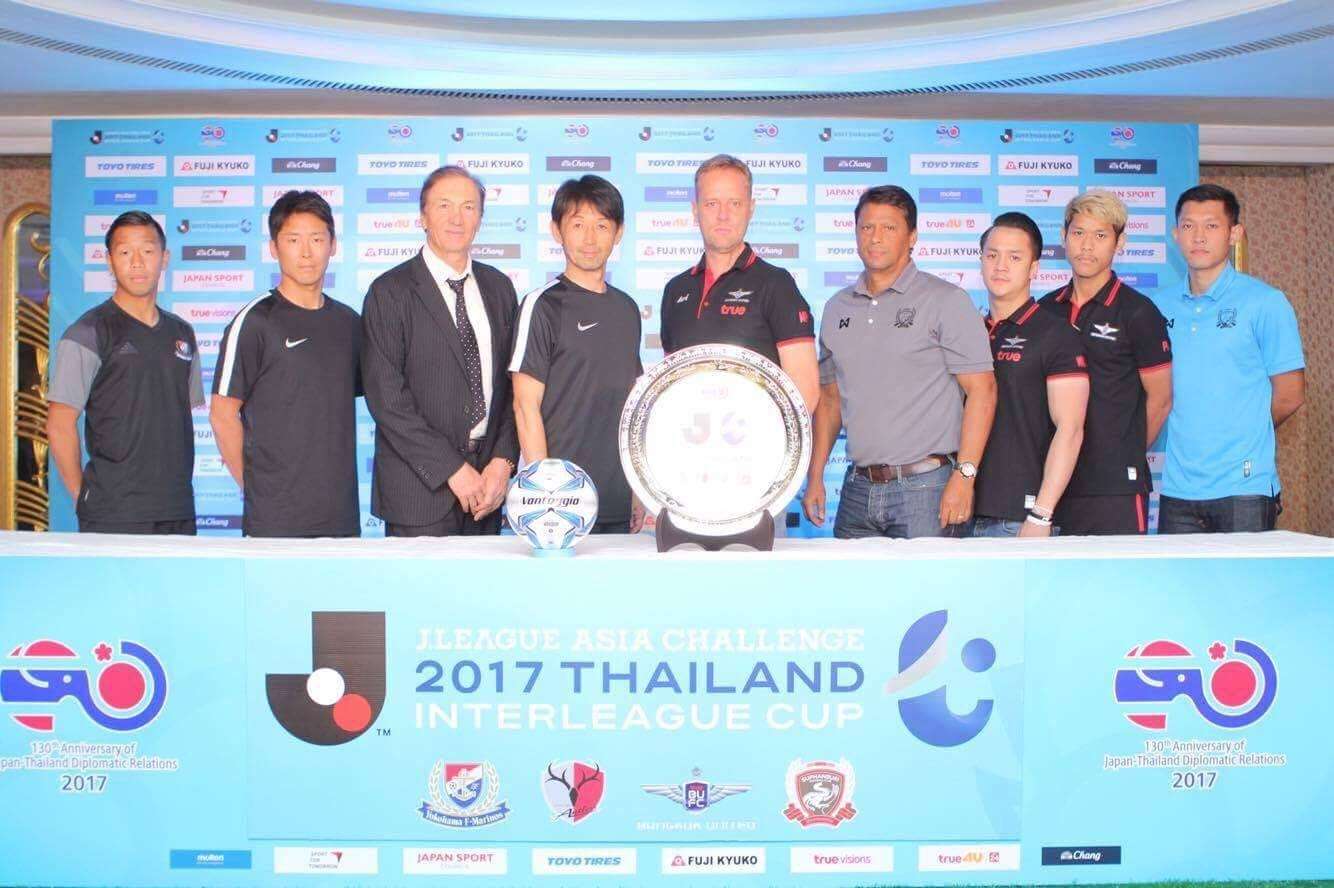The relationship between Southeast Asia and the J.League is deepening. Asian players in the J-League, particular players of Thailand, Vietnam, Indonesia and other ASEAN countries are seen more often as well as many Japanese players in national leagues. Not only the coming and going of players, but also the dispatching of staff and partnerships between clubs are other examples of the deepening relationships.
The J-League which laid out the "Asia Strategy" in 2012, feels a great response to these "achievements" of the past five years. We asked Mr Noriyuki, who is at the centre of the project and acts as a bridge between Japan and the rest of Asia, about the overview and progress of the project and future prospects.
The J.League’s "Asia Strategy" launched in 2012. The reason behind it was the Great East Japan Earthquake on March 11, 2011.
"Back then the national mood of self-restraint because of the disaster and declining economy caused a decline in J.League stadium visitors. My thought was that everyone at the J.League as a whole needs to think about how we can bring life back to football in Japan and contribute to society. My ardent desire to ‘connect with Asia’ was a result of that.
Japanese football has seen a large growth over the past 25 years since the beginning of J.League. Japan has participated in the World Cup for 6 consecutive years since the France World Cup held in 1998 and advanced to the finals in both the 2002 Japan & South Korea tournament and the 2010 South Africa tournament. Japan has become one of the Asian countries referred to as a "powerhouse" as a result.
"As a result, we've been able to earn the utmost respect of football officials of other Asian countries. However, football popularity within Asian countries especially ASEAN countries is actually higher than in Japan. Continued economic growth and the rising population got me thinking that a member of the Japan football industry, we could somehow collaborate with the ASEAN countries.
For example, Thailand invested over 10 billion yen for broadcasting rights acquisition of the English Premier League. But if one country puts such high value on football, it would be a waste of an opportunity not to invest in the development of domestic football. Mr Oya went around mentioning to football officials of each country to “actively move towards fulfilling the big dream of competing in the World Cup”.
They answered "We would very much like to do so. But, we don’t know what and how we would do that.”. I thought that in order to make one country’s sports competitive, organizing a good national team is essential and I would gladly provide assistance as the J.League. If the J.League’s presence would increase in the ASEAN countries, that would work to build a better relationship between those countries.
Then began the J.League’s Asia business strategy, starting with partnerships with each national league. In 2012 the J.League entered into partnership with the Thailand Premier League in February, the Vietnam V.League in June and the Myanmar National League in August the same year, followed by the Cambodia League in May and Singapore S.League in June of 2013, in order to provide the knowledge of training players and league operations which the J.League has cultivated over the years. In addition to these activities, the league has also been committed to social activities such as holding football lessons or supporting by dispatching ex-J.Leaguers to each country.
Through these activities, we’ve learned the people's mindset and football fever and how the football industry functions depending on each country. We noticed that the Thailand League’s skill level was higher than we thought and there were quite a few promising players. If they became to play in the J.League, it would contribute to the strengthening of the Thai league and expansion of the J.League fan base.
 Goalthailand
GoalthailandIn the past, Kazuyoshi Miura and Hidetoshi Nakata signed with the Italy Serie A, which led to more people becoming Serie A fans. Since then, many players went abroad to play which directly linked to bumping up the level of the whole football industry. I thought that the same would happen to the relationship between Japan’s J.League and the ASEAN countries.
Each club which sided with us also actively sought information to acquire players in order to expand strategies and business.
In 2013, Vietnam national player Lê Công Vinh joined Consadole Sapporo. In 2016, another Vietnam rep Nguyen Cong Phuong joined Mito Hollyhock and in 2017, Thailand rep Chanathip Songkrasin joined Consadole Sapporo. During the 2017 season, Chanatip played in 17 games and contributed as a valuable player to the team in remaining in the J1 league.
Mr Oya comments “Mito Hollyhock became the official sponsor of Vietnam Airlines and their corporate logo mark was placed on the back of the uniform. In addition, Vietnam Airlines began direct flights to Ibaraki Airport. On TV, J.League games (only Consadole games) are aired on FTA In Thailand and I’ve heard that the ratings are about the same as the Thailand League. These are significant achievements.”
Information on these benefits is relayed to each club. We are continuing efforts to support clubs that have shown interest, by accompanying them to their country of interest.
“We feel that there are many clubs that would show interest once they know about the details surrounding the ASEAN leagues. Once a touchpoint is established, those touchpoints will be expanded according to the activities of each clubs, such as football lessons which would also be meaningful to football coaches in Japan, in terms of the gaining global experience.
In 2012, Cerezo Osaka partnered with Thailand Bangkok Glass FC and the team visited training camps in Bangkok in before season start. In summer, Bangkok FC set up a training camp in Osaka and an exchange program of several players and coaches was carried out. In addition, Singha beer and Yanmar are each sponsor of Cerezo Osaka and Bangkok Glass respectively. The active exchange has helped the mutual development of each team.
Consadole Sapporo was quick to move in acquiring new Southeast Asian players and signed with Lê Công Vinh in 2013 followed by Indonesia national player Stefano Jantje Lilipaly in 2014, In 2015 another Indonesia rep Irfan Haarys Bachdim and in 2017 Chanatip, which makes 4 players in total. The outcome was a success on and off the pitch such as the increase of Thai visitors attending the stadium in 2017.

FC Tokyo partnered with Bangkok United in 2017 and signed with Jakkit Wachpirom under a fixed-term transfer agreement. Jakkit played for J3 tier team FC Tokyo U-23 and marked his first goal during the final match week.
Mito Hollyhock continues their relationship with Vietnam, established by the joining of Nguyen Cong Phuong and Ibaraki prefecture has started a project to share their agricultural technology. Their connection has expanded to non-football areas.
For other clubs, we are still running activities to build relationships with the ASEAN in a way specific to each and to search for new possibilities.
"Until now, each J.League club received support from each city and community they belong to. However, for the 25 years ahead, we have a responsibility to become a figure that will make the community think “I’m glad we have a club team”. Football is a universal language and will help structure deeper relationships with the ASEAN countries. Examples like Mito will be a good opportunity for teams to return their favours back to the community.”
It has been about 5 years since the start of a full-fledged Asia strategy. We can feel the response of these is significant achievements.
Opportunities to learn about the J.League has clearly increased. News of Chanatip playing is being reported not only in Thailand but all over Southeast Asia. This means the “Awareness” of J.L is evolving into “Interest”. The football relationship between Japan and ASEAN is becoming closer these several years but you wouldn’t know that until you actually go to visit the country. Sanfrecce Hiroshima has just announced that they have signed with Thailand’s national player Teerasil Dangda. We feel that this will draw more attention to the J.League.
There is an increase in Japanese players playing in the Thai League and there are more ASEAN players mentioning that they “want to play in the J.League.”
“I have a feeling our messaging of "'The growth of Asia as one" is spreading bit by bit. Respect for one another is what is solidifying an ideal cooperative relationship. No matter which country we go to, what has been always said at the end of a discussion is “One day we shall compete against each other at the World Cup”. Starting from the 2026 World Cup, the Asian qualifications slots will be raised to 8.5 so that one day is not just a dream. When I imagine of a future where the all qualifying teams each have a few J.League players, it’s really exciting.
The joint cooperation cannot be structured if either side is looking down upon the other. Japan is striving to build a win-win relationship while learning many things and must not forget the mindset of respecting other countries. This project is still in its infancy, but the outcome is greater than expected
Profile: Oya Takeyuki
J.League Marketing Co., Ltd., overseas business divisions and General Manager. Born in 1981. After graduating from the University of Massachusetts Amherst, he joined Japan International Cooperation Agency (JICA) in 2004. In 2009, he joined Japan Professional Football League (J.League), then joined his current company, handling domestic and international business development of the J.LLeague from 2012.
AFC Match Commissioner since 2015.




